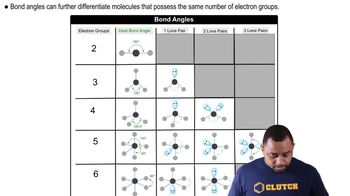Using Lewis symbols and Lewis structures, diagram the formation of SiCl4 from Si and Cl atoms, showing valence-shell electrons. e. How many bonding pairs of electrons are in the SiCl4 molecule?
(b) How many bonding electrons are in the structure?
 Verified step by step guidance
Verified step by step guidance
Verified video answer for a similar problem:
Key Concepts
Bonding Electrons

Lewis Structures

Valence Electrons

Using Lewis symbols and Lewis structures, diagram the formation of PF3 from P and F atoms, showing valence-shell electrons. (a) How many valence electrons does P have initially? (c) How many valence electrons surround the P in the PF3 molecule? (d) How many valence electrons surround each P in the PF3 molecule?
Use Lewis symbols and Lewis structures to diagram the formation of PF3 from P and F atoms, showing valence-shell electrons. e. How many bonding pairs of electrons are in the PF3 molecule?
(c) Do you expect the O—O bond in H2O2 to be longer or shorter than the O—O bond in O2? Explain.
Which of the following statements about electronegativity is or are true? i. The alkali metals are the family with the largest electronegativity values. ii. The numerical values for electronegativity have no units. iii. Electronegativity is the ability of an atom in a molecule to attract electron density toward itself.
Place the following pairs of elements in order from smallest to largest difference in electronegativity: K and F, S and O, Br and I, Ca and Se, Li and Cl.
